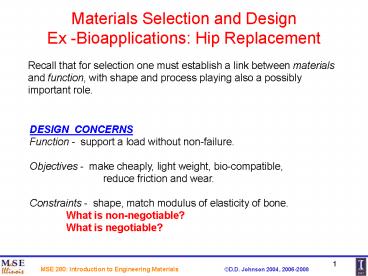Materials Selection and Design PowerPoint PPT Presentation
1 / 9
Title: Materials Selection and Design
1
Materials Selection and Design Ex
-Bioapplications Hip Replacement
Recall that for selection one must establish a
link between materials and function, with shape
and process playing also a possibly important
role.
DESIGN CONCERNS Function - support a load
without non-failure. Objectives - make cheaply,
light weight, bio-compatible, reduce friction
and wear. Constraints - shape, match modulus of
elasticity of bone. What is non-negotiable? What
is negotiable?
2
Bio-Materials Artificial Hip Replacement
Anatomical overview of a hip joint
Joint is susceptible to fracture. Hip can get
osteoarthritis, where small lumps of bone for on
the rubbing surfaces causing pain.
- Bone tissue consists of soft and strong
protein collagen and brittle apatite, with
density of 1.6 to 1.7 g/cm3. - Mechanical properties of bone are highly
anisotropic (axial and radial).
3
Artificial Hip Replacement
- Mechanical properties of bone are highly
anisotropic (axial and radial).
- modulus of elasticity of bone 2-30 GPa,
depending on porosity. - Match bone, or else bone will die around implant
due to lack of use.
4
Artificial Hip Replacement
- There are four components to the artificial hip
femoral stem, ball, acetabular cup, and possible
fixation agent (e.g., epoxy, but highly damaging
- more and more not used).
- Property constraints on materials are stringent
because of chemical (corrosive, biocompatibility)
and mechanical (compatibility) needs.
5
Artificial Hip Replacement
- Biocompatibility produce minimum degree of
rejection. - Products resulting from reactions with body
fluids must be tolerated in surrounding tissue
(toxicity).
- Body fluid is warm 1 wt NaCl plus other salts
and organic compounds. - Corrosion in metals this leads both to uniform
corrosion and to crevice attack and pitting, AND,
to stress-corrosion cracking and fatigue.
Rivet joint in aqueous solution
Pitting in 304 SS plate by acid-chloride solution.
Stress-corrosion cracking in brass
(intergranular).
Electrochemical corrosion - crevice corrosion.
6
Artificial Hip Replacement
- Corrosion effects
- Mechanical behavior plus reduce wear and
friction.
- Max. tolerable corrosion rate for implant metal
alloys is about 2.5 x 10-4 mm/yr, or 0.01
mils/yr. - (See chapt. on corrosion.)
- Stem
- minimum YS (500 MPa) and UTS (650 MPa).
- min. ductility 8EL.
- min. fatigue 400 MPa at 107 cycles.
- elasticity 2-30 GPa, depends on porosity.
- Very hard material will reduce wear.
- Frictional forces should be considered to reduce
wear. - Three other major factors density (light
weight), property reproducibility
(manufacturing), and cost (reasonable). - Last a long time! (No additional operations to
replace again.
7
Artificial Hip Replacement
- Corrosion and Mechanical properties.
- Metal Ti-6Al-4V is most biocompatible, but
stiffer so carriers more load. - 316 SS and Ti alloys not magnetic - important
for MRI use, e.g. - Ceramics, like Alumina, too brittle but are wear
resistant and lower friction stress --- thus use
as coating (hydroxyapatite) as the porous ceramic
scaffolding allows bone to grow into its pores
(integrated systems). - CUP polyethylene, with low friction and good
wear-resistance.
8
Always Consider the BIG PICTURE
- Engineering design and application requires
multifaceted approach. - What you do as an engineering impacts humanity!
- help communities in need,
- reducing labor needs,
- increasing productivity,
- extend exploration,
- enhance safety,
- improve the human condition
- Popular Internet Photo.
- Reality is composite picture from 4 photos made
by underwater photographer R.A. Clevenger (1999). - Two halves of the iceberg are from one taken in
Alaska and one in Antarctica (neither is
underwater). - Underwater part is the background taken off the
coast of California. - The sky is the last component.
- GREAT PICTURE, anyway!
9
SUMMARY
- Materials for biological implants selected based
on - - biocompatibility, mechanical match,
corrosion resistance, friction and wear
resistance, toxicity of local reaction chemistry,
longevity, ease of installation, etc. - Materials for other biological applications
must be similarly considered - - designer proteins for drug-delivery
- toxicity, site-specific delivery,
containment of pharmaceutical, - mechanical properties (rheology).
- BIG PICTURE considerations Teams
- Engineered materials for biological applications
require materials, engineering, biology,
chemistry, surface science, reaction chemistry,
toxicology, etc.

